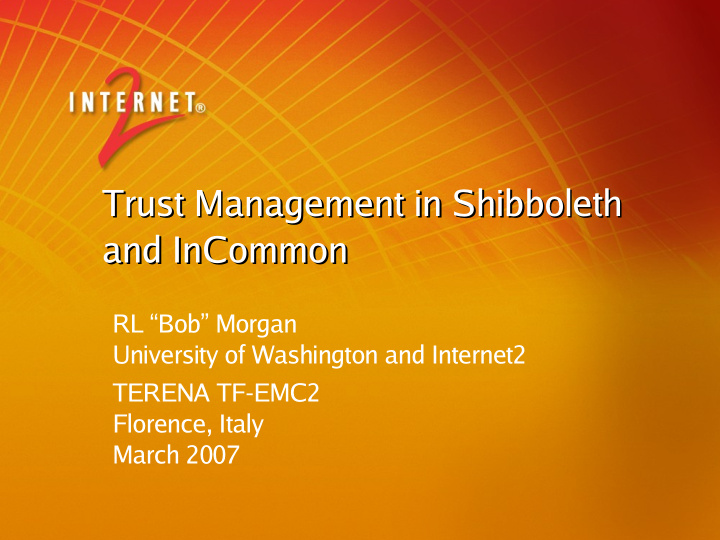



Trust Management in Shibboleth Trust Management in Shibboleth and InCommon and InCommon RL “Bob” Morgan University of Washington and Internet2 TERENA TF-EMC2 Florence, Italy March 2007
Trust management in SAML Trust management in SAML ● really “identity management” for peer entities names, roles, keys, capabilities range of LoAs possible, just like with people support varies widely in products ● SAML defines “metadata” format generally service description format, examples in other technologies such as WS-SecurityPolicy better than “via out of band agreement” better than peer-description format per product doesn't replace product local configuration 2
Trust management in Shibboleth Trust management in Shibboleth • plugin API for “trust engines” decide on validity of signature on signed object (usually a SAML assertion) decide on validity of cert (usually for TLS) • trust engines in Shib 1.3 “shibboleth trust engine” PKIX-based validation, using platform PKIX services keys/CAs listed in metadata “basic trust engine” key-matching validation, using keys listed in metadata generally in certs, but no processing of cert controls 3
Benefits of PKI (for SAML trust mgt) Benefits of PKI (for SAML trust mgt) • standardized validation, path construction • lifecycle management validity periods, key rollover, revocation • flexible naming (DNs, altNames) • extensibility via adding elements to cert • platform support • many existing CAs 4
PKI not-so-benefits PKI not-so-benefits • naming DNs confusing, altNames not well-supported across platforms, tools • key-usage bits, etc, can be trip-ups • path processing inconsistent across platforms eg openssl handling of cert chains • keystores hard to use for sysadmins • no general-purpose cert-acquisition infra • unknown practices at commercial CAs designed to serve SSL web server market 5
CAs and federations CAs and federations • Many federations run fed-specific CA e.g., InCommon, US E-Auth to simplify trust base, vs using general-purpose CA but: adds PKI complexity, loses benefit of use of existing CA infrastructure • peer joining federation often has to get new cert either from fed-specific CA or commercial CA used by federation this is obstacle for some sites 6
CA-less federation? CA-less federation? • all key-handling in metadata? metadata can do this (in Shib), with basic trust engine metadata is essential part of trust base even if PKI used • benefits works consistently across all Shib deployments works consistently across (all?) vendor products no CA ops required • encryption useful in three-tier, other scenarios probably means keys in metadata to work 7
CA-less federation drawbacks? CA-less federation drawbacks? • lifecycle? validity can be expressed in metadata rollover / revocation handled requires metadata refresh by participants at short intervals, this is a good idea anyway • works for TLS? this is trickier, have to bypass platform TLS trust • no paths? reliance on many CAs not common anyway ... • new fed management processes/tools may come, in InCommon, with SAML 2.0 support 8
the future: mixed the future: mixed • many/most feds may still use CAs • many peers may just offer keys ie, refuse to get new cert to establish relationship • implying feds may need to handle both • more future dynamic discovery, dynamic establishment ala OpenID reputation management will these things involve CAs? 9
Recommend
More recommend